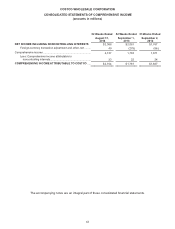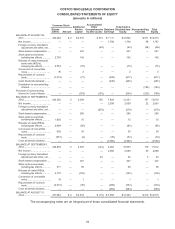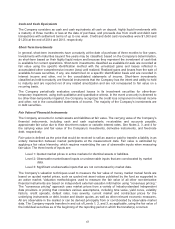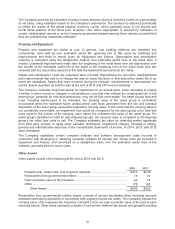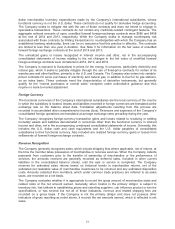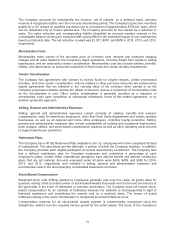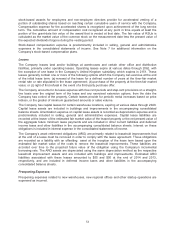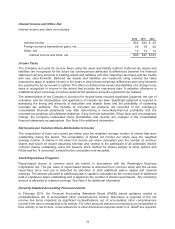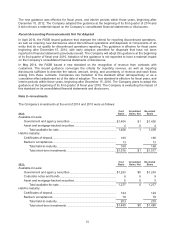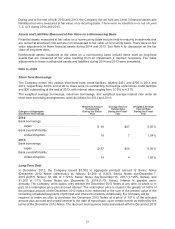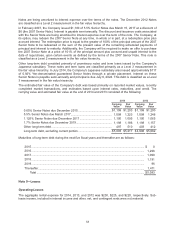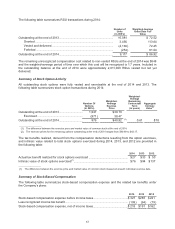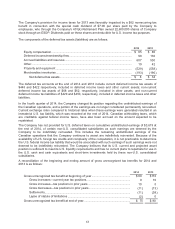Costco 2014 Annual Report Download - page 55
Download and view the complete annual report
Please find page 55 of the 2014 Costco annual report below. You can navigate through the pages in the report by either clicking on the pages listed below, or by using the keyword search tool below to find specific information within the annual report.stock-based awards for employees and non-employee directors provide for accelerated vesting of a
portion of outstanding shares based on reaching certain cumulative years of service with the Company.
Compensation expense for the accelerated shares is recognized upon achievement of the long service
term. The cumulative amount of compensation cost recognized at any point in time equals at least the
portion of the grant-date fair value of the award that is vested at that date. The fair value of RSUs is
calculated as the market value of the common stock on the measurement date less the present value of
the expected dividends forgone during the vesting period.
Stock-based compensation expense is predominantly included in selling, general and administrative
expenses in the consolidated statements of income. See Note 7 for additional information on the
Company’s stock-based compensation plans.
Leases
The Company leases land and/or buildings at warehouses and certain other office and distribution
facilities, primarily under operating leases. Operating leases expire at various dates through 2062, with
the exception of one lease in the Company’s United Kingdom subsidiary, which expires in 2151. These
leases generally contain one or more of the following options which the Company can exercise at the end
of the initial lease term: (a) renewal of the lease for a defined number of years at the then-fair market
rental rate or rate stipulated in the lease agreement; (b) purchase of the property at the then-fair market
value; or (c) right of first refusal in the event of a third-party purchase offer.
The Company accounts for its lease expense with free rent periods and step-rent provisions on a straight-
line basis over the original term of the lease and any exercised extension options, from the date the
Company has control of the property. Certain leases provide for periodic rental increases based on price
indices, or the greater of minimum guaranteed amounts or sales volume.
The Company has capital leases for certain warehouse locations, expiring at various dates through 2040.
Capital lease assets are included in buildings and improvements in the accompanying consolidated
balance sheets. Amortization expense on capital lease assets is recorded as depreciation expense and is
predominately included in selling, general and administrative expenses. Capital lease liabilities are
recorded at the lesser of the estimated fair market value of the leased property or the net present value of
the aggregate future minimum lease payments and are included in other current liabilities and deferred
income taxes and other liabilities in the accompanying consolidated balance sheets. Interest on these
obligations is included in interest expense in the consolidated statements of income.
The Company’s asset retirement obligations (ARO) are primarily related to leasehold improvements that
at the end of a lease must be removed in order to comply with the lease agreement. These obligations
are recorded as a liability with an offsetting asset at the inception of the lease term based upon the
estimated fair market value of the costs to remove the leasehold improvements. These liabilities are
accreted over time to the projected future value of the obligation using the Company’s incremental
borrowing rate. The ARO assets are depreciated using the same depreciation method as the respective
leasehold improvement assets and are included with buildings and improvements. Estimated ARO
liabilities associated with these leases amounted to $55 and $50 at the end of 2014 and 2013,
respectively, and are included in deferred income taxes and other liabilities in the accompanying
consolidated balance sheets.
Preopening Expenses
Preopening expenses related to new warehouses, new regional offices and other startup operations are
expensed as incurred.
53


